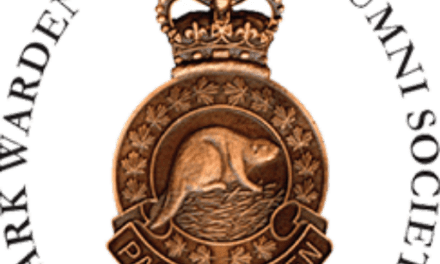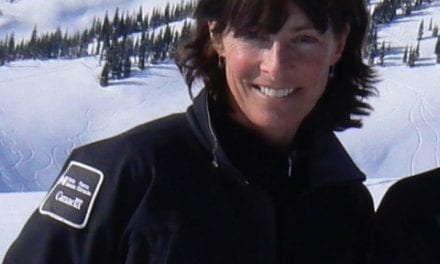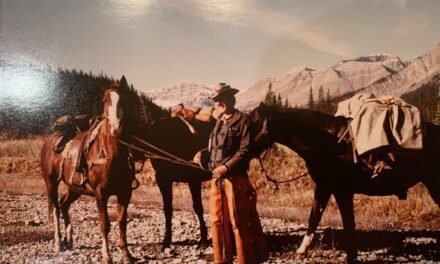The 10 Best Days Working for Parks Canada:
After my first season in Prince Albert, I was extended through the winter. One afternoon I drove to the Kingsmere River and spotted fresh wolf tracks heading towards the river mouth on Waskesiu Lake. As I stood on the lake shore at the mouth of the river the light was already fading and it was trying to snow. Then I heard the howl. Then an answer! Looking towards the locations of the calls I could see six timber wolves of various colors. They were working their way along the forested edge of the lake, calling back and forth, separate and together. I could dimly see them sniffing, marking and milling about until it got dark. It was the first time I ever felt so connected to the idea of “wilderness”. It would not be the last.
The trip with Norma Shepherd and Jack Leader to clean out the Kingsmere Warden Station. When Hal Shepherd became the Chief Park Warden of Yoho, he and Norma had never completely moved out of the Kingsmere Warden Station which was on the north end of the lake back then. It was November and we drove in via the Chipewyan Portage Trait from Crean I think. Anyway, it took us all day to get to the Kingsmere station and back out. On the whole the trails were in good shape and we were able to drive all the way in and out in the 4×4 and only having to cut a few deadfalls. All the way in and out and while looking through the house for personal items, Norma relayed stories of the Shepherd’s life at Kingsmere and how they got there. Bombadiers, slush ice, isolation, home schooling and Prince Albert as the gulag of the Parks system in the 1960s. Rich.
While in Jasper I had a climbing tutor (Gerry Israelson) and an “endearing relationship with the horse” mentor (Gord Antoniuk). One day Gerry showed up and suggested we go and do some climbing practice. I agreed on the condition that we got to the top of something. Gerry and I spent the day on Hilda Peak near Mount Athabasca and it was sublime. Every day on the mountains counts as a “best” day, King’s Throne, Vulcan, Martha Black.
Collecting Whooping Crane eggs. I was given the opportunity to fly with Ernie Kyle, Brian Johnson and Bernie Lief on one of the fights to collect the second Whooping Crane egg from several Wood Buffalo nests: The extra eggs were flown south and incubated either in Idaho Sandhill Crane nests or with the captive flock. We would land with the helicopter and Ernie would go out and collect an egg and bring it back to the plane in a wool sock. Another day of God’s work.
Finding projectile points and cultural debris on the Lake One Dunes. Lake One is a dry and wetland prairie due south of Peace Point in Wood Buffalo. In the late 1970s it was the summer range of 500 bison from the delta. There were also large numbers of breeding Canada Geese and Sandhill Cranes, and a resident pack of wolves denned and raised their pups at Lake One. It was a true prairie Eden. On the south side of the prairie was an area of active sand dunes. My father had told me stories of growing up on the prairies during the depression and the sand blowouts were sources of arrowheads and other stone artifacts. I started looking around the Lake One dunes and quickly found a couple of projectile points and lots of stone flakes and bone. Lake One was later excavated by Parks Canada and Peace Point is a very significant cultural site.
Every day in 1979. The year I never worked. On New Year’s Eve in 1973 I boarded a British Airways flight in Edmonton and flew to London and on to Nairobi. I had banked six weeks of annual leave and spent five of them traveling all over Kenya with Mike Walsh, a park interpreter in Prince Albert who was teaching for CUSO in Nigeria at the time. I returned to Wood Buffalo in mid-February and learned I was going on a law enforcement course in Jasper National Park for two weeks. Then I was sent on the Operation Osmerous (Smelt Run) to Point Pelee National Park in May. Mountaineering Workshop in Nahanni in June. A 13-day canoe trip down the Nahanni River in August. I returned to find I was moving to Fundy. Drove across Canada to Fundy arriving November 11. Do the math; there could not have been more than 3 months of regular work in that year, and during that time I was doing field work for the Wood Buffalo wolf/bison study.
The first adult peregrine returns to Point Wolfe. I was in Fundy National Park when the project to hatch peregrine falcons started at Point Wolfe. I had previously been involved in some survey work with one of the few surviving wild populations at the time in the Peace-Athabasca Delta in Wood Buffalo. During the third year of putting young birds at Point Wolfe, a young adult immediately swooped in to check them out. There was a CBC Moncton news reporter and camera on site that day, also a first. The drama and excitement was amazing, and totally unanticipated. Our project and its initial indication of success made the CBC National News, that night. Talk about feeling like you’re involved in “God’s work”.
The Round Table at Goat Herd Mountain. In its early years, the National Round Table on the Economy and the Environment, met in Haines Junction. Day adventures in Kluane National Park were negotiated as part of the agenda. Brent Liddle and I were the leaders of the outing on Goat Herd Mountain. We had that group in a camp overnight and then did a full day hike to the overlook on the Alsek River and the Lowell Glacier. It was an amazing group, in an amazing place on a perfect day.
The Donjek and Steele Valley. Time in the Steele Valley is what I imagine it was like in the dawn of time in Himalayas.
Mother grizzly nursing her cubs in Vuntut. A grizzly mother lying on her back in the tundra while nursing two cubs, backlighted by the evening light only found in the Arctic summer.
A day in and near Surmalik National Park. I have loved my time in Nunavut but the time at Pond Inlet and Surmalik was the best so far.
Meeting Ambrose Boucher near the Slave River. Charlie Ristau and I met Ambrose on a channel north of Carlson’s Landing. It was the 1970s but this trapper and his dog team were right out of the 1920s. It was like meeting a ghost on the trail.
Majorville Medicine Wheel Field Trip. Learning to pray from a Sitskika elder at one of the largest and perfectly situated medicine wheels on the Great Plains on a Parks Canada Aboriginal Partnership course. The Majorville Cairn and medicine wheel consists of a central cairn, which is linked to a surrounding stone circle by 28 spokes. It is situated on a height of land with an expansive view of the surrounding prairie landscape west of the Bow River in Southern Alberta. Archaeological studies indicate the site has been continuously used for the last 4500 years, making this one of the oldest religious monuments in the world.
Swimming with salmon in Fundy. Swim through surveys of the spawning Atlantic salmon in Fundy’s Upper Salmon River. So beautiful you forgot to get cold. The loss of these fish is a crime against the sacred.
Oh yeah, I cannot count.
The ten worst days working for Parks Canada.
It does not matter because one of the good days negates them all, but it is worth noting they involved unwise use of firearms, alcohol (not always by me), too much time in aircraft or reinventing government.
Duane: I just reread this today and it still stands true.
SH: That’s excellent.
Duane: Memorable events …. a couple of things. It started in PA but in Wood Buffalo as well, when we came in, the cohorts that came in with in 1972, it was a big input right then. I’ve got the old lists, Clair Israelson, and … it’s an impressive list of who was hired into permanent positions about that time. I think they were permanent, but some were seasonal. They were seasonal lists, I guess. It was a really impressive cadre of people, and it was because we were right when the veterans were all retiring. So, there was this big influx, and we all came in at the same time, and then we were also going for promotions at the same time. So interviewing, being interviewed was a big part of the job. I remember we would be coaching each other a bit and talking about “Are you applying on this one?” We would take the feedback we were getting seriously too.
I don’t think there wasn’t much faith in the individual Parks evaluation process. Your goals … you know, monitor the weather station 365 days a year or something like that or remediation of the burned patch were there would be topsoil dumped.
So, we made a little bit of a study out of how to succeed at the interview. When I was in Fundy, just before I came to Jasper, Marguerite and I went on a trip to Europe, and I had come back and there was a Chief’s conference in Halifax. So literally, I came off the plane, home for a night I think, and off to Halifax for the Chief’s conference. Coincidentally at the same time, they were interviewing for GT-5 and GT-6 maybe, I don’t know, but they were creating a national Chief’s list. I’d been on a pretty spectacular vacation, and Chief’s meeting, all the backslapping and feel-good stuff, and going into the interview, it was the first time when I went into an interview that I didn’t give a shit.
I was totally in a zone where I just was free to soak up the experience and let it go. I came out the number one candidate.
So anyway, out of that, that was why Dumpleton looked seriously at me going to Jasper and I was still on the same list when Kluane came open. So, it was like that sort of, memorable because I was riding high, but it does a lot for your self-confidence …. I’ve got something going on here and I’ve got something to offer. So that’s the attitude that I had in Jasper, when I was working with a team of really strong people, and I was like, “Okay, we could do a lot together”. That was fun.
You can go through periods in your career when you can get worn down. In that period, I was not the least worn down. The organization was being affirming, and I thought as well that something exciting could happen. It did for a while, and then we went on to re-inventing government. Then you did get worn down. Hope that makes a little bit of sense.
SH: Yes, it does. That period in my career too with Darro and you as the Chiefs in Jasper and Gerry in Public Safety was so fun and so dynamic as you say.
SH: How did the Warden Service change over the years? Centralization, affirmative action, changes in 1990s and 2000s.
Duane: The change…I came in at the cusp of one change; the end of the districts. Up until then warden jobs had been a high degree of independence, personal responsibility, you had a pretty defined territory, and you were responsible for all things around that territory. Communication, fire response, how you kept your shop and your little acreages or empires in the land. That’s where the pride in the job came from and then they were put into this fluid, amorphous organization.
It wasn’t until I got to Kluane when again we were faced with re-organizational models and justification of what we were doing and how we were applying the concepts of ecological integrity in our parks. By moving geographically through a number of parks, I had processed a lot of the changes by changing parks. Whereas those people who’d only been in one park for all that change, saw it very differently because they were always measuring the requirement to change against one background where they were. I could see the personal toll it took on them and I had a lot more sympathy for some of the people who had to process all that change in one place, watching something that had been really important to them, something they’d been personally responsible for, get neglected. It was no longer a priority, and you are still there? So anyway, the change was phenomenal, and it was very hard on many wardens. There was a lot of how people responded….
Thinking about the number of people, that list you sent, “Who should we talk to?” How many people I’ve worked with who are not associated with the organization at all, haven’t been for years and years. There were some exceptional people that left, drifted out because of many reasons but largely because they didn’t feel their contribution was valued by the organization, and it should have been.
SH: That’s a really great answer Duane. (Tape 20:54)
SH: What about the Warden Service was important to you? Preservation, protection, keeping people safe, etc.?
Duane: In the actual job, the work of natural resource management, it definitely got more complex, and we changed our perspectives, and also solved some problems, so we could move on to others, like bear management, the work that was done by individuals and Parks over time. To tackle that issue … good solutions. So, I think from my perspective it was always grounded resource management, and that was where my interests were, but also it was the core of the important work we did in terms of its value back to Parks. You could make the same statement about public safety, in terms of pay back to the visiting public.
I always have seen law enforcement as only being useful to Parks, as it was an extension of resource management. I always thought it was a mistake that we were trying to manage traffic flow and we should have just let that go to the RCMP a long time ago. In terms of specialized law enforcement around protecting resources was important. I see it as resource management.
As a sub-text, in my career, challenging perceptions around what Parks were about or wanted. I worked hard at trying to show people that we were motivated by concern for the resources and it wasn’t a powerplay. It was what was best for the resource …. that’s what we were motivated by.
SH: Are there any legends or stories associated with the Warden Service that you can share? Is there anyone in the Warden Service that stands out in your mind?
Duane: I had put two names down in this category, but there’s so many. I consider almost everybody I worked with is worthy of a legend. I can’t think of almost anybody that doesn’t have a great story associated with them. But a couple of people that had a big influence on me… One of them was Francois Millette. Did you ever meet him?
SH: No



